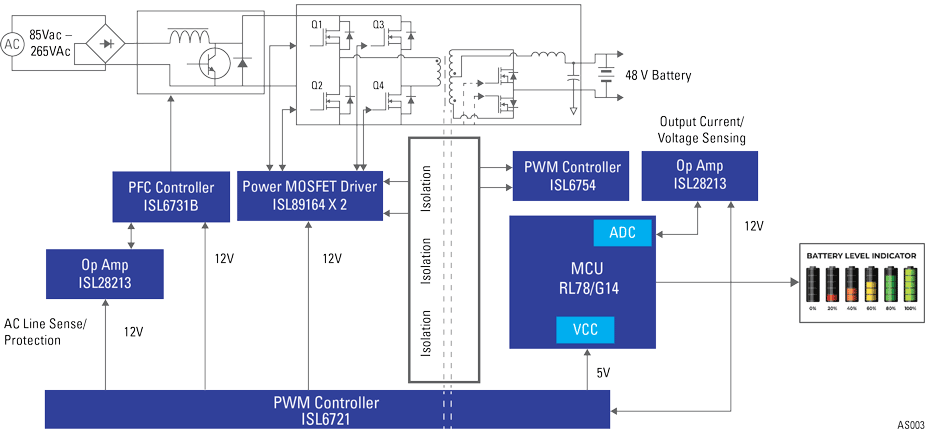The automotive transportation industry is transforming. More advanced electronic systems are being designed into cars, enabling vehicle electrification, and increasing automation, safety, comfort and convenience. As electro-mobility (e-mobility) increasingly becomes part of daily life, there is a growing need for more efficient charging solutions. Electric Vehicles (EVs) can help broaden the number of fuel choices available for transportation. EVs can also reduce the emissions that contribute to climate change and smog, improving public health and reducing ecological damage. Fueling with electricity offers some advantages not available in conventional internal combustion engine vehicles. Electric motors are very responsive and offer very good torque. EVs are also often more digitally-connected than conventional vehicles.
This reference design approach utilizes an active power factor correction controller (ISL6731B), an asymmetrical full-bridge zero voltage switching (ZVS) converter (ISL6754) as the heart of the system, and an auxiliary supply using the ISL6721 and RL78/G14 (or the high temperature/automotive-grade RL78/F14) MCU for EV charger applications (Figure 1).
The ISL6731B active power factor correction (PFC) controller has unique features, such as negative capacitance to provide low THD, high PF, and compact EMI filter components, which results in superior performance and a lower cost solution. A patent-pending breakthrough, negative capacitance technology minimizes zero crossing distortion and reduces the size of the magnetic components. The small external components result in lower design costs without sacrificing performance. With its superior performance, Renesas’ PFC controller outperforms other digital PFCs in the market.
The ISL6754 is a high-performance ZVS full-bridge PWM controller with features like average current monitoring and soft-start. It achieves ZVS operation by driving the upper bridge FETs at a fixed 50% duty cycle, while the lower bridge FETs are trailing-edge modulated with the ability to achieve ZVS for both upper and lower FETs.
This solution also gives customers the option to program current and voltage settings by using MCUs such as the RL78/G14 (or the automotive-grade RL78/F14) to ensure that the battery is safely and correctly charged. MCU features include battery health indictors, load connect-disconnect features for user safety, and several other system benefits such as:
- Patented ZVS switching and clamping topology to minimize power losses, EMI emission and voltage stress on both primary and secondary FETs
- True PWM operation allows diode mode operation at light load to guarantee high light load efficiency and reliable dynamic performance
- Conventional magnetic design provides the lowest cost, fastest time to market and easiest production compared to customized magnetic designs
- True peak current mode control eliminates the DC block capacitor in primary FB
Visit the winning combinations page to see more winning combination solutions that help our customers accelerate their designs to get to market faster.

Figure 1. Electric Vehicle (EV) Charger Block Diagram
